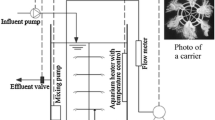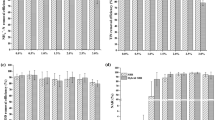Abstract
The effects of hydraulic retention time on the performance and microbial community structure of an anoxic–aerobic sequencing batch reactor treating saline wastewater were investigated. The average removal efficiencies of chemical oxygen demand and ammonia nitrogen decreased from 90 and 85 % to 68 and 71 % with the decrease in hydraulic retention time from 17 to 9 h, respectively. No obvious accumulation of nitrate nitrogen and nitrite nitrogen in the effluent was found. The contents of polysaccharide and protein in extracellular polymeric substances increased with the decrease in hydraulic retention time. The polysaccharide/protein ratio decreased from 1.18 to 1.11 with the decrease in hydraulic retention time from 17 to 9 h. The increase in extracellular polymeric substances with the decrease in hydraulic retention time led to the increase in sludge volume index. The specific ammonium oxidation rate, specific nitrite oxidation rate, specific nitrate reduction rate, and specific oxygen uptake rate increased with the decrease in hydraulic retention time. The diversity indices of microbial community decreased from 2.69 to 2.39 with the decrease in hydraulic retention time from 17 to 9 h. The α-proteobacteria were the dominant groups under hydraulic retention time of 17, 14, 11, and 9 h, which constituted 46, 30, 40, and 40 % of the whole microbial community, respectively.






Similar content being viewed by others
References
Barr TA, Taylor JM, Duff SJB (1996) Effect of HRT, SRT and temperature on the performance of activated sludge reactors treating bleached kraft mill effluent. Water Res 30:799–810
Boopathy R, Bonvillain C, Fontenot Q, Kilgen M (2007) Biologcial treatment of low-salinity shrimp aquaculture wastewater using sequencing batch reactor. Int Biodeterior Biodegrad 59(1):16–19
Campos J, Mosquera-Corral A, Sánchez M, Méndez R, Lema J (2002) Nitrification in saline wastewater with high ammonia concentration in an activated sludge unit. Water Res 36(10):2555–2560
Chang IS, Lee CH (1998) Membrane filtration characteristics in membrane-coupled activated sludge system-the effect of physiological states of activated sludge on membrane fouling. Desalination 120:221–233
Chen H, Zhou SG, Li TH (2010) Impact of extracellular polymeric substances on the settlement ability of aerobic granular sludge. Environ Technol 31:1601–1612
Chinese NEPA (2002) Water and wastewater monitoring methods, 4th edn. Chinese Environmental Science Publishing House, Beijing
Chistoserdova L, Lapidus A, Han C, Goodwin L, Saunders L, Brettin T, Tapia R, Gilna P, Lucas S, Richardson PM, Lidstrom ME (2007) Genome of Methylobacillus flagellatus, molecular basis for obligate methylotrophy, and polyphyletic origin of methylotrophy. J Bacteriol 189:4020–4027
Dan NP, Visvanathan C, Basu B (2003) Comparative evaluation of yeast and bacterial treatment of high salinity wastewater based on biokinetic coefficients. Bioresour Technol 87:51–56
de-Bashan LE, Moreno M, Hernandez JP, Bashan Y (2002) Removal of ammonium and phosphorus ions from synthetic wastewater by the microalgae Chlorella vulgaris coimmobilized in alginate beads with the microalgae growth-promoting bacterium Azospirillum brasilense. Water Res 36:2941–2948
Dubois M, Gilles KA, Hamilton JK, Rebers PA, Smith F (1956) Colorimetric method for determination of sugars and related substance. Anal Chem 28:350–356
Durai G, Rajasimman M, Rajamohan N (2011) Aerobic digestion of tannery wastewater in a sequential batch reactor by salt-tolerant bacterial strains. Appl Water Sci 1:35–40
Felsenstein J (1985) Confidence limits on phylogenies: an approach using the bootstrap. Evolution 39:783–791
Fontenot Q, Bonvillain C, Kilgen M, Boopathy R (2007) Effects of temperature, salinity, and carbon: nitrogen ratio on sequencing batch reactor treating shrimp aquaculture wastewater. Bioresour Technol 98(9):1700–1703
Gebauer R (2004) Mesophilic anaerobic treatment of sludge from saline fish farm effluents with biogas production. Bioresour Technol 93(2):155–167
Han H, Zhang YY, Cui CC, Zheng SK (2010) Effect of COD level and HRT on microbial community in a yeast-predominant activated sludge system. Bioresour Technol 101:3463–3465
Hu Z, Zhang J, Xie HJ, Li SP, Wang JH, Zhang TT (2011) Effect of anoxic/aerobic phase fraction on N2O emission in a sequencing batch reactor under low temperature. Bioresour Technol 102:5486–5491
Hwang JH, Cicek N, Oleszkiewicz JA (2009) Inorganic precipitation during autotrophic denitrification under various operating conditions. Environ Technol 30:1475–1485
Isaka K, Kimura Y, Yamamoto T, Osaka T, Tsuneda S (2013) Complete autotrophic denitrification in a single reactor using nitritation and anammox gel carriers. Bioresour Technol 147:96–101
Jang D, Hwang Y, Shin H, Lee W (2013) Effects of salinity on the characteristics of biomass and membrane fouling in membrane bioreactors. Bioresour Technol 141:50–56. doi:10.1016/j.biortech.2013.02.062
Jørgensen KS, Pauli ASL (1995) Polyphosphate accumulation among denitrifying bacteria in activated sludge. Anaerobe 1:161–168
Jørgensen NOG, Brandt KK, Nybroe O, Hanse M (2009) Delftia lacustris sp. nov., a peptidoglycan-degrading bacterium from fresh water, and emended description of Delftia tsuruhatensis as a peptidoglycan-degrading bacterium. Int J Syst Evol Microbiol 59:2195–2199
Kapdan IK (2005) Kinetic analysis of dyestuff and COD removal from synthetic wastewater in an anaerobic packed column reactor. Process Biochem 40:2545–2550
Kargi F, Uygur A (2003) Nutrient removal performance of a five-step sequencing batch reactor as a function of wastewater composition. Process Biochem 38:1039–1045
Kim BY, Weon HY, Yoo SH, Kwon SW, Cho YH, Stackebrandt E, Go SJ (2006) Paracoccus homiensis sp. nov., isolated from a sea-sand sample. Int J Syst Evol Microbiol 56:2387–2390
Kim YM, Park DH, Jeon CO, Lee DS, Park JM (2008) Effect of HRT on the biological pre-denitrification process for the simultaneous removal of toxic pollutants from cokes wastewater. Bioresour Technol 99:8824–8832
Kumar S, Tamura K, Nei M (2004) MEGA3: integrated software for molecular evolutionary genetics analysis and sequence alignment. Brief Bioinform 5:150–163
Lai Q, Qiao N, Wu C, Sun F, Yuan J, Shao Z (2010) Stappia indica sp. nov., isolated from deep seawater of the Indian Ocean. Int J Syst Evol Microbiol 60:733–736
Lefebvre O, Moletta R (2006) Treatment of organic pollution in industrial saline wastewater: a literature review. Water Res 40:3671–3682
Lefebvre O, Vasudevan N, Torrijos M, Thanasekaran K, Moletta R (2005) Halophilic biological treatment of tannery soak liquor in a sequencing batch reactor. Water Res 39:1471–1480
Li XY, Yang SF (2007) Influnce of loosely bound extracellular polymeric substances (EPS) on the flocculation, sedmentation and dewaterability. Water Res 41:1022–1230
Li HY, Zhang Y, Yang M, Kamagata Y (2013) Effects of hydraulic retention time on nitrification activities and population dynamics of a conventional activated sludge system. Front Environ Sci Eng 7:43–48
Lowery OH, Rosebrough NJ, Farr AL, Randall RJ (1951) Protein measurement with the Folin phrnol reagent. J Biol Chem 193:265–275
Moussa MS, Hooijmans CM, Lubberding HJ, Gijzen HJ, van Loosdrecht MCM (2005) Modelling nitrification, heterotrophic growth and predation in activated sludge. Water Res 39:5080–5098
Moussavi G, Barikbin B, Mahmoudi M (2010) The removal of high concentrations of phenol from saline wastewater using aerobic granular SBR. Chem Eng J 158(3):498–504
Muda K, Aris A, Salim MR, Ibrahim Z, van Loosdrecht MCM, Ahmad A, Nawahwi MZ (2011) The effect of hydraulic retention time on granular sludge biomass in treating textile wastewater. Water Res 45:4711–4721
Muyzer G, de Waal EC, Uitterlinden AG (1993) Profiling of complex microbial populations by denaturing gradient gel electrophoresis analysis of polymerase chain reaction-amplified genes coding for 16S rDNA. Appl Environ Microbiol 59:695–700
Ng HY, Ong SL, Ng WJ (2005) Effects of sodium chloride on the performance of a sequencing batch reactor. J Environ Eng 131:1557–1564
Onyenwoke RU, Kevbrin VV, Lysenko AM, Wiegel J (2007) Thermoanaerobacter pseudethanolicus sp. nov., a thermophilic heterotrophic anaerobe from Yellowstone National Park. Int J Syst Evol Microbiol 57:2191–2193
Panswad T, Anan C (1999) Impact of high chloride wastewater on an anaerobic/anoxic/aerobic process with and without inoculation of chloride acclimated seeds. Water Res 33(5):1165–1172
Park SJ, Lee TW, Yoon TI (2004) Production of extracellular polymeric substances in anoxic/oxic process with zeolite carriers for nitrogen removal. Biotechnol Lett 26:1653–1657
Rene ER, Kim SJ, Park HS (2008) Effect of COD/N ratio and salinity on the performance of sequencing batch reactors. Bioresour Technol 99:839–846
Saitou N, Nei M (1987) The neighbor-joining method-a new method for reconstructing phylogenetic trees. Mol Biol Evol 4:406–425
Shannon CE, Weaver W (1949) The mathematical theory of communication. University of Illinois Press, Urbana
Sheng GP, Yu HQ, Li XY (2010) Extracellular polymeric substances (EPS) of microbial aggregates in biological wastewater treatment systems: a review. Biotechnol Adv 28:882–894
Shi BH, Arunpairojana V, Palakawong S, Yokota A (2002) Tistrella mobilis gen nov, sp nov, a novel polyhydroxyalkanoate-producing bacterium belonging to α-Proteobacteria. J Gen Appl Microbiol 48:335–343
Shi K, Zhou WZ, Zhao HX, Zhang YZ (2012) Performance of halophilic marine bacteria inocula on nutrient removal from hypersaline wastewater in an intermittently aerated biological filter. Bioresour Technol 113:280–287
Wang X, Zeng RJ, Dai Y, Peng Y, Yuan Z (2008) The denitrification capability of cluster 1 Defluviicoccus vanus-related glycogen-accumulating organisms. Biotechnol Bioeng 99:1329–1336
Wang Y, Peng Y, Stephenson T (2009) Effect of influent nutrient ratios and hydraulic retention time (HRT) on simultaneous phosphorus and nitrogen removal in a two-sludge sequencing batch reactor process. Bioresour Technol 100:3506–3512
Xie CH, Yokota A (2006) Reclassification of [Flavobacterium] ferrugineum as Terrimonas ferruginea gen. nov., comb. nov., and description of Terrimonas lutea sp. nov., isolated from soil. Int J Syst Evol Microbiol 56:1117–1121
Yang HJ, Shao P, Lu TM, Shen JQ, Wang DF, Xu ZN, Yuan X (2006) Continuous bio-hydrogen production from citric acid wastewater via facultative anaerobic bacteria. Int J Hydrogen Energy 31:1306–1313
Zhang XQ, Bishop PL (2001) Spatial distribution of extracellular polymeric substances in biofilms. J Environ Eng 127:850–856
Zhang ZP, Show KY, Tay JH, Liang DT, Lee DL, Jiang WJ (2006) Effect of hydraulic retention time on biohydrogen production and anaerobic microbial community. Process Biochem 41:2118–2123
Zhang ZJ, Chen SH, Wang SM, Luo HY (2011) Characterization of extracellular polymeric substances from biofilm in the process of starting-up a partial nitrification process under salt stress. Appl Microbiol Biotech 89:1563–1571
Acknowledgments
The work was funded by the National Natural Science Foundation of China (No. 51178437).
Author information
Authors and Affiliations
Corresponding author
Rights and permissions
About this article
Cite this article
Wang, Z.C., Gao, M.C., Ren, Y. et al. Effect of hydraulic retention time on performance of an anoxic–aerobic sequencing batch reactor treating saline wastewater. Int. J. Environ. Sci. Technol. 12, 2043–2054 (2015). https://doi.org/10.1007/s13762-014-0594-z
Received:
Revised:
Accepted:
Published:
Issue Date:
DOI: https://doi.org/10.1007/s13762-014-0594-z




